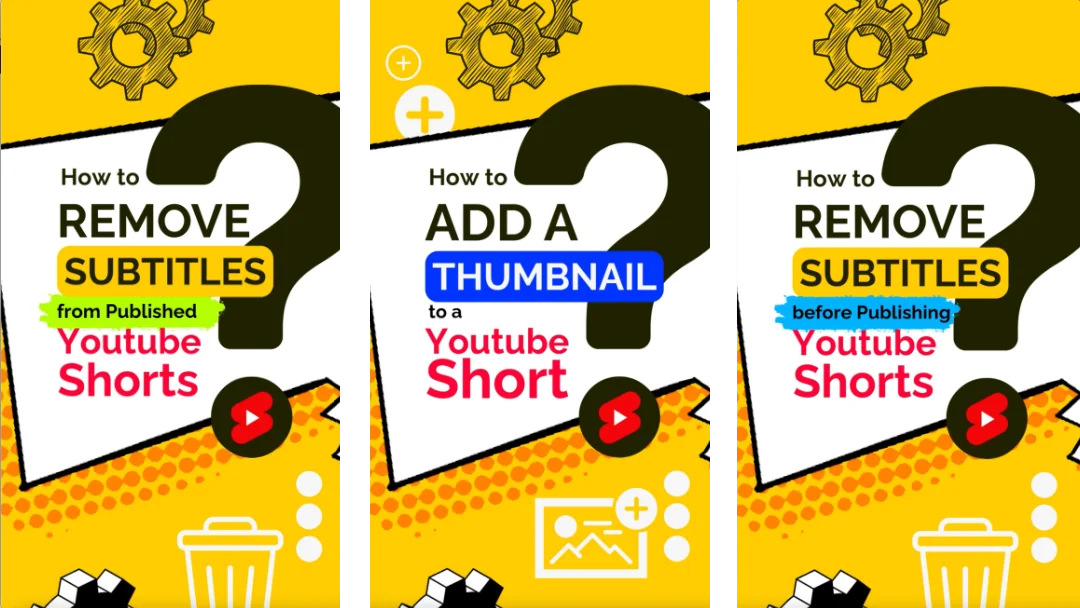Learn how to add a thumbnail to YouTube Shorts and remove subtitles or auto-generated captions. Check out these visual step-by-step guides.

Step-by-Step Guides to Add Thumbnail to YouTube Shorts and Remove Captions
YouTube Shorts are a powerful way to reach new audiences — but controlling how they appear is just as important. If you have ever wondered how to add a thumbnail to YouTube Shorts or how to remove subtitles, these guides walk you through everything step by step. Every explanation is paired with a dedicated Short to demonstrate the process in action.
How to Add Thumbnail to YouTube Shorts
Thumbnails matter — even on Shorts. Here’s how to add a thumbnail to YouTube Shorts properly:
How to Add Thumbnail to YouTube Shorts on Mobile (YouTube App)
1. Open the YouTube app (not Studio) and find your Short
2. Tap the three-dot menu (⋮) next to the video, then select Edit
3. Tap the thumbnail preview or pencil icon to choose a frame
4. Drag the slider to select your desired frame
5. Tap Done, then Save
How to Add Thumbnail to YouTube Shorts on Desktop
Currently, YouTube does not allow uploading custom thumbnails for Shorts on desktop or mobile. To control your thumbnail, you must use the mobile app and select a frame from your video.
How to Remove Subtitles from Video on YouTube Shorts
What’s the Difference Between Captions and Subtitles on YouTube Shorts?
If you want to manage captions or subtitles, it helps to know the difference — even though YouTube sometimes uses the terms interchangeably. Subtitles are a type of caption, but not all captions are subtitles.
Captions include everything that is heard in a video — spoken words, sound effects, and music. They are designed to help people who are deaf or hard of hearing. Subtitles, on the other hand, only show the spoken dialogue and are often used to translate speech into another language. They don’t include background sounds or audio cues.
On YouTube Shorts, auto-generated captions usually appear in YouTube Studio. So, deleting subtitles means removing these auto-captions from your video.
How to Delete Subtitles from Video on Published YouTube Shorts
If YouTube automatically added subtitles to your published Short, here’s how to remove them:
1. Go to YouTube Studio
2. Click Content in the left menu.
3. Find your Short and click the pencil icon (Details)
4. In the left sidebar, select Subtitles
5. Under the language track (e.g., “English (automatic captions)”), click the bin icon or the three-dot menu
6. Choose Delete
7. Click Save to apply the changes
How to Turn Off or Remove Captions Before Publishing YouTube Shorts
To prevent auto-generated subtitles from appearing when you upload a Short:
1. Start uploading your Short
2. In the Video Elements step, look for Add Subtitles
3. Click the three-dot menu (⋮) next to auto-generated captions
4. Select DeleteThis stops captions from showing when your video goes live.
More Helpful Guides and Quick Marketing Tips
I hope you found these guides on how to add thumbnails to YouTube Shorts and remove subtitles or captions helpful. Be sure to explore more digital marketing tips on this site and on the International SEO Consultant Resource Hub for additional simple and practical guides.
How to Add Thumbnail to YouTube Shorts and Remove Subtitles or Captions – FAQs
How do I add a thumbnail to YouTube Shorts?
Use the YouTube mobile app. During or after upload, tap Edit, select a frame to use as the thumbnail, and tap Save. Custom images can’t be uploaded for Shorts.
How do I add a thumbnail to YouTube Shorts on a desktop?
You can’t add a custom thumbnail to YouTube Shorts on desktop, as Shorts use an auto-generated frame as the thumbnail.
What is the difference between Shorts and Reels?
Shorts are YouTube’s short-form videos, while Reels are Instagram’s, offering more effects and stickers. Both engage audiences but differ in platform, tools, and user experience.
What is the difference between Shorts and Reels?
Shorts are YouTube’s short-form videos, while Reels are Instagram’s, offering more effects and stickers. Both engage audiences but differ in platform, tools, and user experience.






